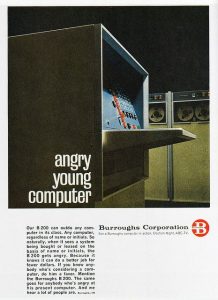 The Burroughs Corporation found itself part of computing history in 1953 when it moved into computers for the banking industry. By the 1960s the company had risen to the top of the computing heavyweights, competing with IBM, GE, and RCA in the mainframe market.
The Burroughs Corporation found itself part of computing history in 1953 when it moved into computers for the banking industry. By the 1960s the company had risen to the top of the computing heavyweights, competing with IBM, GE, and RCA in the mainframe market.
Like IBM, Burroughs produced all of their own systems and peripherals including printers, disk drives, and more. The architecture of a Burroughs machine was based what is called language directed design, and used instruction sets that could be done with COBOL or FORTRAN. The company went on to produce a slew of popular and innovative computers and business machines until 1986, when it was merged with Sperry Corporation to form Unisys, which is still producing computers and providing a whole range of IT services as of 2016.

